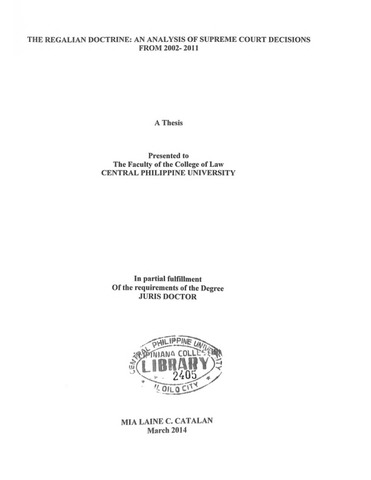The regalian doctrine: an analysis of Supreme Court decisions from 2002- 2011
| dc.contributor.adviser | Alibogha, Salex E. | |
| dc.contributor.author | Catalan, Mia Laine C. | |
| dc.date.accessioned | 2021-02-05T05:17:55Z | |
| dc.date.available | 2021-02-05T05:17:55Z | |
| dc.date.issued | 2014 | |
| dc.identifier.citation | Catalan, M. L. C. (2014). The regalian doctrine: an analysis of Supreme Court decisions from 2002- 2011 (Unpublished postgraduate thesis). Central Philippine University, Jaro, Iloilo City. | en_US |
| dc.identifier.uri | https://hdl.handle.net/20.500.12852/176 | |
| dc.description | Abstract only | en_US |
| dc.description.abstract | This study was conducted to determine and compare Supreme Court decisions invoking the Regalian Doctrine and its implications regarding different principles of law in a period of ten (10) years or from 2002-2011 involving different claims. It also aims to determine the proper interpretation of law, quantum of evidence and related principles and doctrines in land titles and registration proceedings. This is a qualitative study using content analysis research design. The study includes Supreme Court decisions regarding land registration cases in which the Regalian Doctrine was invoked and was put as an issue. From 2002-2011, there have been 46 cases which either sustained or did not uphold the Regalian Doctrine. All 46 cases were studied, compared and analysed. The results showed that the Regalian Doctrine has been strictly applied and upheld in land ownership. There being a presumption under jura regalia that all lands belong to the State, the burden to overturn such presumption lies with the applicant of land registration by clear, positive and convincing evidence of ownership by any of the modes of acquisition and provided that the land applied for forms part of the alienable land of the State. The State may dispose of agricultural lands by any of the following: 1) homestead patent; 2) sale; 3) lease; and 4) by judicial confirmation of imperfect or incomplete titles. To rebut the ix presumption under the Regalian Doctrine, the applicant must prove that he acquired the land by any of the modes provided above. The cases in which the Regalian Doctrine is frequently placed in issue is the mode of acquisition by judicial confirmation of imperfect or incomplete titles. The applicant must prove the following: (a) that the land forms part ofthe alienable and disposable agricultural lands ofthe public domain; and (b) that they have been in open, continuous, exclusive and notorious possession and occupation of the same under a bona fide claim of ownership either since time immemorial or since June 12, 1945.The land must be declared to be alienable and disposable by a positive act of the government. Mere casual cultivation is insufficient to prove possession in the concept of an owner. Tax declarations are not proofs of ownership but are merely indicia of ownership for no one in his right mind would pay taxes of property which he is not in possession of. Unless the aforementioned are proven by incontrovertible evidence, the presumption under the Regalian Doctrine remains. If ownership of the land has been transferred to a private person under fraud or misrepresentation, the State can institute an action for reversion under the Regalian Doctrine, the State being the rightful owner. | en_US |
| dc.format.extent | iii, 59 leaves | en_US |
| dc.language.iso | en | en_US |
| dc.subject.ddc | GSL Theses 340.72 C280 | en_US |
| dc.subject.lcsh | Real property | en_US |
| dc.title | The regalian doctrine: an analysis of Supreme Court decisions from 2002- 2011 | en_US |
| dc.type | Thesis | en_US |
| dc.description.bibliographicalreferences | Includes bibliographical references | en_US |
| dc.contributor.department | College of Law | en_US |
| dc.description.degree | Juris Doctor | en_US |
| local.subject | Regalian doctrine | en_US |
| local.subject | Land ownership | en_US |
| local.subject | Jura regalia | en_US |
Files in this item
This item appears in the following Collection(s)
-
Juris Doctor [144]


